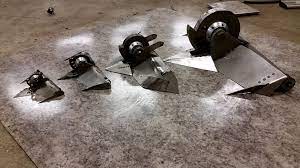RobotClasses
Robot Classes
To keep matches fair robots compete against robots that are in a similar "class". This is most commonly defined by the weight allowed for the robot but there are other things like weapon-type or robot-construction that determine classes. If you are thinking of building a robot you should find out what classes are allowed in your local event. Be aware that the "Antweight" and "Beetleweight" classes differ across events as shown below, so be sure to know what you are allowed to do before you build your robot. Note that some robot classes are very popular while others are very rare, so before you build a 6lb Mantisweight bot be sure that your local event runs that weight class.
Weight Classes
These weight classes are primarily determined by the maximum weight allowed for the robot. Some rules also have size restrictions so be sure to read the rules for your local event.
| Class | SPARC (USA) | FRA (UK) | Special |
|---|---|---|---|
| Fleaweight | 75g | -- | -- |
| Fairyweight | 150g | -- | -- |
| Antweight | 1lb | 150g | -- |
| Beetleweight | 3lb | 1.5kg | -- |
| Mantisweight | 6lb | -- | -- |
| Dogeweight | 15lb | -- | National Robotics League |
| Featherweight | 30lb | 30lb | -- |
| Lightweight | 60lb | -- | -- |
| Middleweight | 120lb | -- | -- |
| Heavyweight | 220lb | 100kg | -- |
| TV-Heavyweight | 250lb | -- | BattleBots |
Often weight bonuses will be offered for specific design features. For example, SPARC rules allow for bots to be up to 50% heavier for bots which shuffle instead of roll, or double weight for bots which fully qualify as Non-Wheeled. Likewise, BattleBots heavyweights can currently be up to 500.0 pounds if they can walk using articulated legs, and meet a number of other design criteria.
Weapon Restricted Classes
These robot classes align with an existing weight class, but have further restrictions on what weapons can be used as well as other possible restrictions on things like using ground-scraping wedges. These classes may be less destructive for builders who don't want their creations so easily destroyed. They are often used for events where they don't have an arena that can safely contain a full-combat robot; for example, spinning weapons may be forbidden, or limited in kinetic energy.
Before entering this type of competition, please read your event's rules to understand the restrictions.
- 150g (Non-destructive)
- 12lb (Tabletop)
- 12lb (Sportsman)
- 30lb (Sportsman)
- 30lb (Tabletop)
- 60lb (Sportsman)
- 250lb (Sportsman)
Construction Restricted Classes
These classes place restrictions on construction materials and methods.
Plastic Ant
In an effort to make robot building more accessible the plastic antweight class was started by Western Allied Robotics. These robots are primarily 3d printed but can be fabricated out of approved plastics. The robot class became popular and the rules were adopted by Sparc.tools.
Termiteweight
There are kits to construct combat robots from laser-cut wood pieces. They have all the parts needed to construct the robot and the transmitter, but no spares in case of damage. This type of bot is humorously known as "termite weight," and while they could in theory be entered into organized competition in the 1lb class, they have many serious disadvantages compared to normal 1lb opponents, such as plastic motor gears, lower battery capacity, and slower battery charging. Termite kits are fun, but are unlikely to succeed against more robust bots.
Lego
There have also been attempts to build and fight combat robots using Lego® bricks, motors, and remote controls, particularly within the Lego builders communities. Events like BrickCan Bots and BattleBricks showcase building Lego bots with many of the common combat robot weapons, with structures for optimal defense against hard impacts. These events often require the use of official Lego motors, which have plastic gearboxes which are easily broken, so this type of bot is unlikely to survive an encounter with a regular combat robot of a similar weight.
Historic Weight Classes
This article covers much of the history of weight classes in robot combat.
Learn about the original 1999 Lego Robogladiators from Dan at Team Delta.
